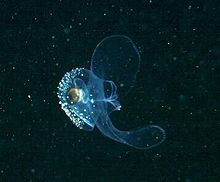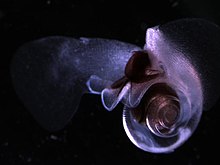Thecosomata
| Sea butterflies Temporal range: Late Paleocene–recent |
|
|---|---|
 |
|
| Unidentified thecosome | |
 |
|
| Limacina helicina | |
| Scientific classification | |
| Kingdom: | Animalia |
| Phylum: | Mollusca |
| Class: | Gastropoda |
| (unranked): |
clade Heterobranchia clade Euthyneura clade Euopisthobranchia clade Thecosomata Blainville, 1824 |
| Families | |
|
Limacinidae |
|
Limacinidae
Cavoliniidae
Clioidae
Creseidae
Cuvierinidae
Praecuvierinidae
Peraclididae
Cymbuliidae
Desmopteridae
Sea butterflies, scientific name Thecosomata (thecosomes, "case/shell-body"), are a taxonomic suborder of small pelagic swimming sea snails. These are holoplanktonic opisthobranch gastropod mollusks in the informal group Opisthobranchia. They include some of the world's most abundant gastropod species.
Along with its sister group, the Gymnosomata, this group is included in the pteropods. The validity of this clade is not unanimously established; although it had fallen out of favour for a number of years, recent molecular evidence suggests that the taxon should be resurrected. Most Thecosomata have a calcified shell, whereas mature Gymnosomata do not.
These snails float and swim freely in the water, and are carried along with the currents. This has led to a number of adaptations in their bodies. The shell and the gill have disappeared in several families. Their foot has taken the form of two wing-like lobes, or parapodia, which propel this little animal through the sea by slow flapping movements. They are rather difficult to observe, since the shell (when present) is mostly colorless, very fragile and usually less than 1 cm in length. Although their shell may be so fine as to be transparent, it is nevertheless calcareous; their shells are bilaterally symmetric and can vary widely in shape: coiled, needle-like, triangular, globulous.
...
Wikipedia
